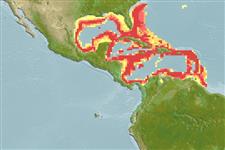Common names from other countries
Environment: milieu / climate zone / depth range / distribution range
Ecologie
Rifbewoner; diepteverspreiding 0 - 2000 m (Ref. 87091). Tropical; 33°N - 8°N, 98°W - 58°W (Ref. 847)
Western Atlantic.
Length at first maturity / Size / Gewicht / Leeftijd
Maturity: Lm ? range ? - ? cm
Korte beschrijving
Morfologie
Colonies are encrusting to massive. Corallites with numerous septa tightly compacted giving a smooth surface. Septa are uniformly separated and reduce numbers from the wall to the columella without forming many fan-like fusions. Usually light reddish brown in color.
Zooxanthellate (Ref. 116012). Common throughout the Caribbean on protected shallow reefs or deeper reefs (Ref. 415).
Life cycle and mating behavior
Geslachtsrijpheid | Voortplanting | Kuitschieten | Eieren | Fecundity | Larven
Mature gametes are shed into the coelenteron and spawned through the mouth. Life cycle: The zygote develops into a planktonic planula larva. Metamorphosis begins with early morphogenesis of tentacles, septa and pharynx before larval settlement on the aboral end (Ref. 833).
Collin, R., M.C. Díaz, J. Norenburg, R.M. Rocha, J.A. Sánchez, M. Schulze, A. Schwartz and A. Valdés. 2005. (Ref. 415)
Status op de Rode Lijst van het IUCN (Ref. 130435)
Status bij CITES (Ref. 108899)
Not Evaluated
Gebruik door de mens
| FishSource |
Tools
Meer informatie
Leeftijd/Grootte
Groei
Lengte-gewicht parameters
Lengte-lengte parameters
Morfologie
Larven
Abundantie
Internet-bronnen
Estimates based on models
Preferred temperature
(Ref.
115969): 6.2 - 16.9, mean 10.3 (based on 212 cells).
Prijsklasse
Unknown.
